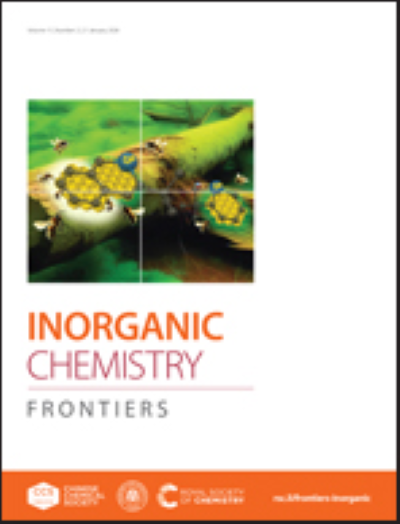Structure–property relationships of unsupported diiridium(II) complexes with variation of axial ligand
IF 6.4
1区 化学
Q1 CHEMISTRY, INORGANIC & NUCLEAR
引用次数: 0
Abstract
While iridium(III) complexes have been extensively studied, unsupported diiridium(II) complexes with Ir(II)–Ir(II) bonds remain underexplored. On the basis of our previous work on the related diiridium(II) complexes with variation of pincer ligand, herein we report the synthesis and characterization of two series of diiridium(II) complexes, anion series (axial X− ligands) and P series (axial phosphine ligands), to investigate effect of axial ligands and charge on the modulation of molecular structure of Ir–Ir bonding, photophysics, and electrochemistry. Halide ions (I−, Br−, Cl−, SCN−) and phosphines with electron-donating/withdrawing substituents were introduced on the axial position and trans to the Ir–Ir bond. X-ray crystallography revealed shorter Ir–Ir bonds in the anion series (2.7567(3)–2.7807(5) Å) compared to the P series (2.9129(6)–2.9303(8) Å), attributed to the weaker trans influence. Photoluminescence studies showed tunable emission (581–676 nm) and photoluminescence quantum yields. Computational studies are also performed to corroborate the corresponding photophysical and electrochemical behaviours. Our findings reveal the significant impact of axial ligand characteristics on the bonding and photophysical properties of these less explored diiridium(II) complexes, contributing to a deeper understanding of their structure–property relationships.

随轴向配体变化的非负载型二铱配合物的结构-性质关系
虽然铱(III)配合物已被广泛研究,但具有Ir(II) -Ir (II)键的非负载型铱(II)配合物仍未得到充分研究。在前人研究钳形配体变化的基础上,本文合成并表征了阴离子系列(轴向X−配体)和P系列(轴向膦配体)两个系列的二铱(II)配合物,探讨了轴向配体和电荷对Ir-Ir键分子结构的调节、光物理和电化学的影响。卤化物离子(I−,Br−,Cl−,SCN−)和具有供电子/吸电子取代基的膦离子在轴向位置被引入并转移到Ir-Ir键上。x射线晶体学显示阴离子系列(2.7567(3)-2.7807 (5)Å)与P系列(2.9129(6)-2.9303 (8)Å)相比,Ir-Ir键较短,这是由于反式影响较弱。光致发光研究显示了可调谐的发射(581-676 nm)和光致发光量子产率。计算研究也进行了证实相应的光物理和电化学行为。我们的研究结果揭示了轴向配体特征对这些较少探索的二铱(II)配合物的成键和光物理性质的重大影响,有助于更深入地了解它们的结构-性质关系。
本文章由计算机程序翻译,如有差异,请以英文原文为准。
求助全文
约1分钟内获得全文
求助全文
来源期刊

Inorganic Chemistry Frontiers
CHEMISTRY, INORGANIC & NUCLEAR-
CiteScore
10.40
自引率
7.10%
发文量
587
审稿时长
1.2 months
期刊介绍:
The international, high quality journal for interdisciplinary research between inorganic chemistry and related subjects
 求助内容:
求助内容: 应助结果提醒方式:
应助结果提醒方式:


